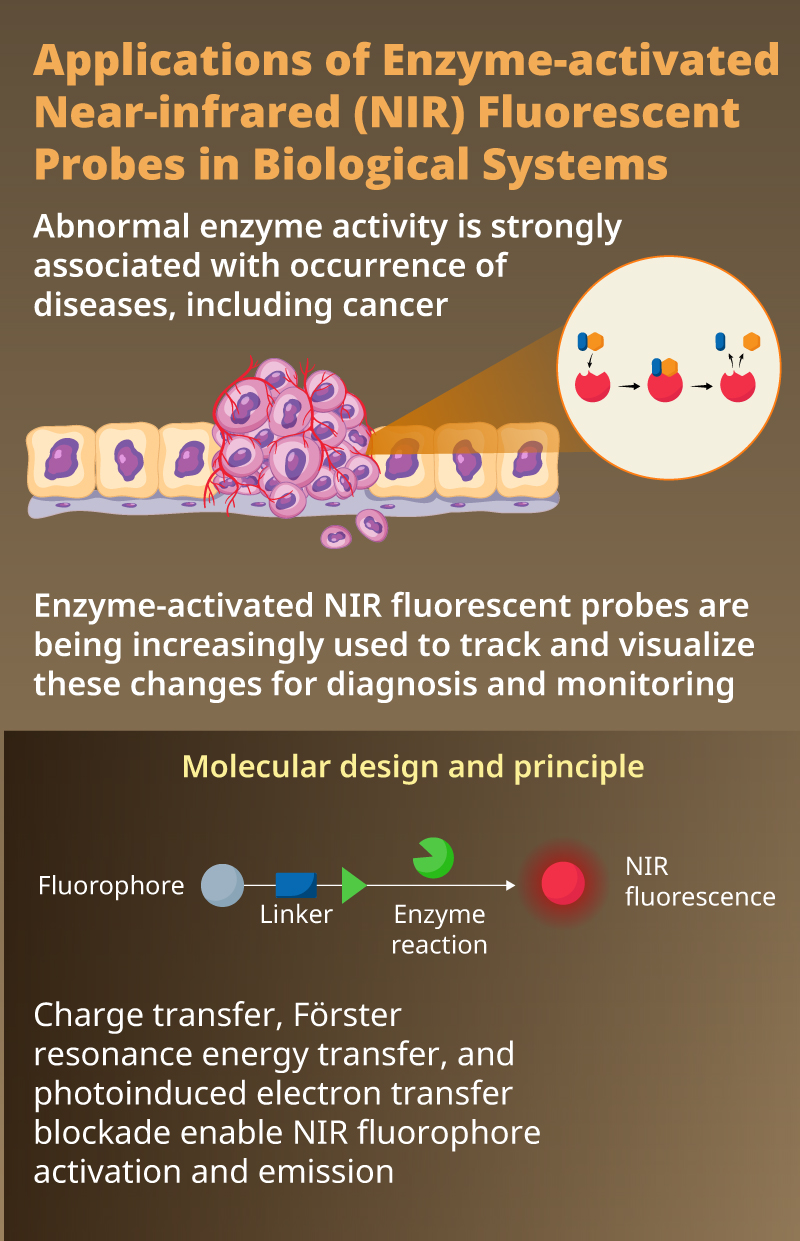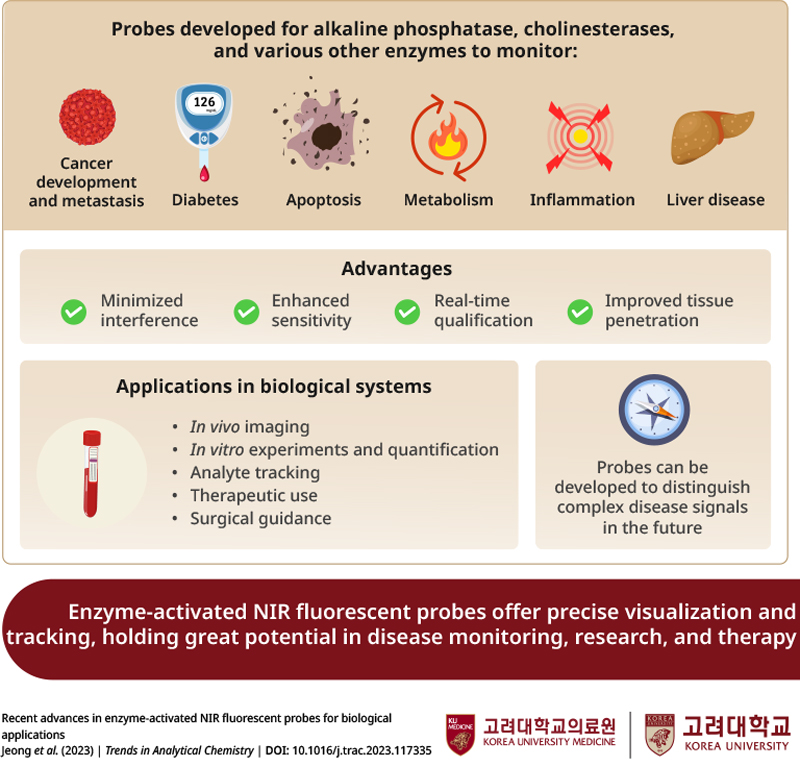Korea University and Ewha Womans University Researchers
Highlight Advancements in Biomedical Research with Enzyme-activated Fluorescent Probes
The review
describes recent advances in the development of enzyme-activated near-infrared fluorescent probes, and their
applications in research and medicine
Enzymes are biocatalysts that play crucial roles in normal cellular processes, and their abnormal activity is
often linked to diseases, including cancer. Detecting and tracking these aberrant enzymes is essential for
diagnosis. In a recent review, researchers detail the latest advances in enzyme-activated near-infrared
fluorescent probes, highlighting their non-invasive and effectiveness in visualizing and measuring enzyme
activity. The review underscores the bio-applications and advantages these probes hold over conventional
techniques.


Image title: Applications of enzyme-activated near-infrared fluorescent probes in biological systems
Image caption: : Abnormal enzyme activity is a hallmark of several diseases including cancer, neurodegeneration, inflammation, and metabolic disorders. Enzyme-activated near-infrared fluorescent probes have emerged as highly sensitive and specific visualization tools for the real-time monitoring of enzyme activity. This review highlights recent advances in the development of enzyme-activated fluorescent probes, and their diverse applications in biomedical research, diagnostics and healthcare.
Image credit: Cheong et al., Korea University
License type: Original Content
Usage restrictions: Cannot be reused without permission
Enzymes, essential for normal cellular and physiological functions, are implicated in various diseases like cancer and diabetes due to their abnormal activity. Therefore, tracking enzyme activity is a valuable strategy for the diagnosis and monitoring of diseases. Conventional imaging techniques are limited by the need for contrast agents, low sensitivity, and spatio-temporal resolution. To overcome these limitations, researchers are increasingly investigating fluorescent probes for non-invasive and real-time visualization of enzyme dynamics and corresponding disease status.
In a new review article, researchers from Korea have summarized the latest advancements in the development of enzyme-activated near-infrared (NIR) fluorescent probes and their diverse applications in biomedical research and medicine. Providing further insight into their article, the lead authors, Professor Jun-Seok Lee from Korea University College of Medicine, and Professor Juyoung Yoon from Ewha Womans University in Korea, explained, “While conventional biomarker examination relies on the comparative expression level of a target enzyme, it does not reflect enzymatic activity. Enzyme-activated fluorescent probes can help monitor the dynamics of enzyme activity in vitro and in vivo.” The review article became available online on 27th September 2023, and will be published in Volume 168 of
Trends in Analytic Chemistry in November 2023.
Enzyme-activated fluorescent probes primarily consist of three components: a fluorophore that emits fluorescence upon activation, a linker, and an enzyme recognition unit. When the probe encounters the target enzyme, the resulting charge or energy transfer activates the NIR-fluorophore, emitting detectable fluorescence. The authors describe various design strategies for these adaptable fluorescent probes, with versatile applications in studies targeting enzymes involved in metabolic processes, neurotransmission, cell growth and cell death, and other key processes.
NIR-fluorescent probes are widely used in biomedical imaging to visualize cells and tissues, and they provide highly sensitive and real-time measurements of enzyme activity in cells, as well as animal disease models. Their selectivity allows for the detection of aberrant enzymes specific to certain tumors or diseases, aiding early and differential diagnosis. Additionally, they are used to outline tumor margins or specific tissues, guiding surgical resection, and hold promise in the assessing therapeutic responses to enzyme-targeting therapies. Furthermore, their applications extend to environmental sensing, food safety, water, and air analysis.
Enzyme-activated fluorescent probes offer high specificity and sensitivity, excellent biocompatibility, ease of use, and tunable properties, making them valuable assets in biomedical research and healthcare. Further studies can help in the designing of multi-target fluorescent probes capable of distinguishing between different cell types and aiding in clinical research, diagnostics, disease monitoring, and treatments. Overall, these probes hold significant potential to revolutionize healthcare.
Kim.
This review enhances our understanding of fluorescent probes and lays the foundation for future research that can expand their applications. The authors conclude by saying, “Abnormal enzyme activity is a hallmark of several diseases. NIR fluorescent probes can be used as molecular tools for visualization and quantification of such biomarkers. While significant advances have been made in their development, additional studies are needed to widen their bioapplications”
Reference
Title of original paper:Recent advances in enzyme-activated NIR fluorescent probes for biological applications
Journal:Trends in Analytical Chemistry
DOI: https://doi.org/10.1016/j.trac.2023.117335
About the Korea University Medicine
Korea University College of Medicine is the medical school of Korea University. It is located in Seoul, South Korea. As
one of the oldest medical schools in South Korea, it has been historically regarded as one of the country's top medical
schools. The school was founded as Chosun Women's Medical Training Institute in 1928 by Rosetta Sherwood Hall. The
institute was subsequently renamed several times and ultimately merged with Korea University to become Korea University
College of Medicine. So far, the school has produced over 7,000 graduates, most of whom are working as prominent
physicians and public health advocates worldwide.
About the author
Prof. Juyoung Yoon
Prof. Yoon is a distinguished faculty at the Department of Chemistry and Nanoscience, Ewha Womans University's, and is recognized among the world's top 1% researchers by Clarivate Analytics. This accolade, conferred to the most influential researchers globally, has been awarded to Prof. Yoon for three consecutive years, underscoring his prominence in the scientific realm. With over 30 patents and three technology transfers to his name, his contributions are both academically profound and practically impactful. Notably, Prof. Yoon's research excellence is evident, with a ranking of 6 in citations per international paper.
Prof. Jun-Seok Lee
Prof. Lee is an associate professor in the Department of Pharmacology, Korea University College of Medicine, where his research focuses on chemical sensing techniques and chemoproteomics. He received his Ph.D. in 2009 from New York University, working on a diversity-oriented BODIPY library for bioimaging probe development. After his doctoral studies, he joined KIST, where he served as a principal research scientist, and moved to Korea University College of Medicine in 2021. Since 2021, he has been an editorial advisory board member of ChemBioChem and an associate editor of Proteome Science.



